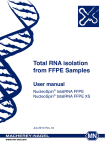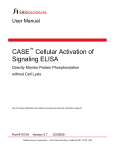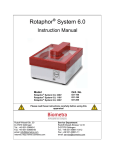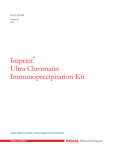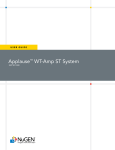Download User Guide
Transcript
User Guide Affymetrix® Chromatin Immunoprecipitation Assay Protocol P/N 702238 Rev. 4 For research use only. Not for use in diagnostic procedures. Trademarks Affymetrix®, Axiom®, Command Console®, CytoScan™, DMET™, GeneAtlas®, GeneChip®, GeneChip-compatible™, GeneTitan®, Genotyping Console™, myDesign™, NetAffx®, OncoScan™, Powered by Affymetrix™, PrimeView™, Procarta®, and QuantiGene® are trademarks or registered trademarks of Affymetrix, Inc. USB, the logo design, and PrepEase are registered trademarks of USB Corporation. All other trademarks are the property of their respective owners. Limited License Subject to the Affymetrix terms and conditions that govern your use of Affymetrix products, Affymetrix grants you a nonexclusive, non-transferable, non-sublicensable license to use this Affymetrix product only in accordance with the manual and written instructions provided by Affymetrix. You understand and agree that except as expressly set forth in the Affymetrix terms and conditions, that no right or license to any patent or other intellectual property owned or licensable by Affymetrix is conveyed or implied by this Affymetrix product. In particular, no right or license is conveyed or implied to use this Affymetrix product in combination with a product not provided, licensed or specifically recommended by Affymetrix for such use. Patents Arrays: Products may be covered by one or more of the following patents: U.S. Patent Nos. 5,445,934; 5,744,305; 5,945,334; 6,140,044; 6,399,365; 6,551,817; 6,733,977; 7,629,164; 7,790,389 and D430,024 and other U.S. or foreign patents. Products are manufactured and sold under license from OGT under 5,700,637. PrepEase products are covered under European Patent EP 0496822 and US Patent 6,428,703. Copyright © Affymetrix Inc. All rights reserved. Contents Chapter 1 Overview . . . . . . . . . . . . . . . . . . . . . . . . . . . . . . . . . . . . . . . . . . . . . . . . . . . . . 4 Introduction . . . . . . . . . . . . . . . . . . . . . . . . . . . . . . . . . . . . . . . . . . . . . . . . . . . . . . . . . . . . .4 Chromatin Immunoprecipitation Assay Protocol Optimization . . . . . . . . . . . . . . . . . . . . . . . .4 Materials . . . . . . . . . . . . . . . . . . . . . . . . . . . . . . . . . . . . . . . . . . . . . . . . . . . . . . . . . . . . . . .6 Buffers . . . . . . . . . . . . . . . . . . . . . . . . . . . . . . . . . . . . . . . . . . . . . . . . . . . . . . . . . . . . . . .8 Miscellaneous Reagents and Supplies . . . . . . . . . . . . . . . . . . . . . . . . . . . . . . . . . . . . . . . .9 Chapter 2 Chromatin Immunoprecipitation Assay . . . . . . . . . . . . . . . . . . . . . . . . . . . . 11 Procedure A: Prepare Cells . . . . . . . . . . . . . . . . . . . . . . . . . . . . . . . . . . . . . . . . . . . . . . . . .11 Procedure B: Fix Cells, Lyse, and Sonicate Whole Cell Extracts . . . . . . . . . . . . . . . . . . . . . . .11 Adherent Cells . . . . . . . . . . . . . . . . . . . . . . . . . . . . . . . . . . . . . . . . . . . . . . . . . . . . . . . .11 Suspension Cells . . . . . . . . . . . . . . . . . . . . . . . . . . . . . . . . . . . . . . . . . . . . . . . . . . . . . . .11 Wash Cell Pellet . . . . . . . . . . . . . . . . . . . . . . . . . . . . . . . . . . . . . . . . . . . . . . . . . . . . . . .12 Procedure C: Check Sonication Efficiency . . . . . . . . . . . . . . . . . . . . . . . . . . . . . . . . . . . . . .12 Procedure D: Incubate With Specific Antibody . . . . . . . . . . . . . . . . . . . . . . . . . . . . . . . . . . .13 Procedure E: Immunoprecipitate and Wash . . . . . . . . . . . . . . . . . . . . . . . . . . . . . . . . . . . . .14 Procedure F: Reverse Crosslinks . . . . . . . . . . . . . . . . . . . . . . . . . . . . . . . . . . . . . . . . . . . . . .15 Procedure G: Cleanup De-crosslinked Samples . . . . . . . . . . . . . . . . . . . . . . . . . . . . . . . . . .15 Procedure H: PCR Amplify Immunoprecipitated DNA Targets . . . . . . . . . . . . . . . . . . . . . . .15 Procedure I: Fragment Amplified Targets . . . . . . . . . . . . . . . . . . . . . . . . . . . . . . . . . . . . . . .19 Procedure J: Label Fragmented Double-Stranded DNA . . . . . . . . . . . . . . . . . . . . . . . . . . . .20 Chapter 3 Hybridization and Array Processing . . . . . . . . . . . . . . . . . . . . . . . . . . . . . . . 21 Procedure A: Hybridize Labeled Target on the Arrays . . . . . . . . . . . . . . . . . . . . . . . . . . . . .21 Procedure B: Array Wash, Stain and Scan . . . . . . . . . . . . . . . . . . . . . . . . . . . . . . . . . . . . . .22 Appendix A Cleanup of Double-Stranded DNA . . . . . . . . . . . . . . . . . . . . . . . . . . . . . . . . 23 Cleanup of Double-Stranded DNA . . . . . . . . . . . . . . . . . . . . . . . . . . . . . . . . . . . . . . . . . . .23 Brief Protocol for Concentration, Desalination and/or Removal of Enzymes . . . . . . . . . . .23 Brief Protocol for PCR Purification . . . . . . . . . . . . . . . . . . . . . . . . . . . . . . . . . . . . . . . . . .23 Brief Protocol for DNA Purification from Chromatin Immunoprecipitation (ChIP) Assay . .24 Appendix B Contact Information . . . . . . . . . . . . . . . . . . . . . . . . . . . . . . . . . . . . . . . . . . . 25 1 Overview Introduction The Affymetrix® Chromatin Immunoprecipitation (ChIP) Assay is designed to generate double-stranded labeled DNA targets that identify sites of protein-DNA interactions or chromatin modifications on a genome-wide scale. This assay has been designed specifically for use with Affymetrix GeneChip® Tiling Arrays for ChIP-on-chip studies in order to study transcription factor binding sites, histone protein modifications, and other chromatin-protein interactions. ChIP experiments can be used as a powerful tool to complement RNA transcription studies because they enable researchers to study the DNA-protein interactions that regulate gene expression. Following the protocol, cells are first fixed with formaldehyde to crosslink DNA to any associated proteins. The cells are then lysed and DNA is sheared into smaller fragments using sonication. Protein-DNA complexes are then immunoprecipitated with an antibody directed against the specific protein of interest. Following the immunoprecipitation, crosslinking is reversed, samples are protease-treated and the purified DNA sample is amplified using a random-primed PCR method. Subsequently, targets are fragmented and labeled to hybridize onto GeneChip® Tiling Arrays. By comparing the hybridization signals generated by an immunoprecipitated sample versus an antibody-negative or non-specific antibody control, the regions of chromatin-protein interaction can be identified. Studies were performed at Affymetrix to evaluate the robustness and sensitivity of the ChIP assay; however, because of the variability associated with the quality and affinity of various antibodies against their intended targets, results may vary from one antibody to the next. The procedure outlined in this protocol describes all the necessary steps and reagents for fixing cells, fragmenting chromatin, immunoprecipitating sheared chromatin, amplifying and labeling precipitated DNA. We would like to acknowledge Mark Biggin and Xiao-Yong Li of the Lawrence Berkeley National Lab for sharing their modifications to the ChIP protocol. We have incorporated their improvements to the amplification step (on page 15) with their approval. Chromatin Immunoprecipitation Assay Protocol Optimization This protocol has been developed for use with GeneChip® Tiling Arrays. Exact protocol conditions will require optimization by each user due to the variability inherent in: Experimental Biology: cell types, proteins of interest, antibodies Assay conditions: DNA fragmentation, PCR conditions To ensure success with this protocol, it is critical that users optimize the following steps in the ChIP protocol prior to performing microarray hybridizations. Additional information on the optimization steps are available throughout this protocol. 1. Sonication conditions of fixed cells. Some cells are resistant to sonication treatment. Micrococcal nuclease treatment may improve DNA shearing for some cell lines. 2. Antibody Qualification. Antibodies should be qualified for use with chromatin immunoprecipitation experiments. ChIP qualification information is available from www.chiponchip.org or directly from antibody vendors. 3. Antibody Titration. Antibody affinities and avidities can vary, so the amount of antibody may need to be titrated to achieve optimal sample enrichment. 4. PCR amplification of immunoprecipitated DNA. The optimal number of PCR cycles may require optimization to avoid saturation and ensure that the IP enrichment is maintained. Chapter 1 | Overview 5 5. QPCR Positive Control. A QPCR control is recommended to test ChIP conditions. This test requires a known protein binding to a known DNA sequence. After performing ChIP with an antibody to the known protein, QPCR is used to verify that the known DNA binding elements are enriched in experimental vs. negative control samples. This QPCR test can also be used to ensure that the enrichment of experimental samples vs. control samples is maintained after IP column clean up. Figure 1.1 Chromatin Immunoprecipitation Assay Schematic Fix cells to crosslink DNA to protein Sonicate to lyse cells and shear chromatin Day 1 Take small aliquot to decrosslink and check sonication efficiency Immunoprecipitate main sample with selected antibody Couple to Protein-A beads and wash to purify IP'd DNA Decrosslink and proteinase treat IP'd DNA Sample Cleanup Linear Amplification Day 2 Clean up IP'd DNA Random Primer/Adapter Sequenase, dNTPs Adapter 5' 3' 5' 3' Adapter Primer, dNTP + dUTP, Taq polymerase 5' 3' 5' 3' PCR amplify and incorporate dUTP 5' U 3' U 3' 5' 5' 3' U U U 3' U 5' Uracil DNA Glycosylase APE 1 Fragmentation Day 3 + Fragment and label amplified DNA target Terminal Deoxynucleotidyl Transferase DLR (Biotin-labeled) Terminal Labeling + Hybridization SAPE Biotinylated anti-streptavidin antibody Hybridize arrays Washing/Staining Day 4 Scanning Legend Proteins Antibody Protein-A beads DNA Chapter 1 | Overview Materials Table 1.1 Materials Required Material Source Part Number Formaldehyde Solution (37%), 500 mL Sigma-Aldrich F8775 Glycine, 1 kg Sigma-Aldrich 50046 Phosphate Buffered Saline (PBS) pH 7.4 (1X), liquid Various IGEPAL® CA-630 Sigma-Aldrich 9036-19-5 Phenylmethanesulfonyl Fluoride Solution (PMSF), 250 mL Sigma-Aldrich 93482 Microccocal Nuclease (MNase) (Optional) USB 70196Y EGTA (optional) Sigma-Aldrich E3889-100G Protease Inhibitor Tablet Roche 11873580001 Proteinase K New England BioLabs P8102S LiCl (8M), 500 mL Sigma-Aldrich L7026 Glycogen Roche 10901393001 Triton-X100 (non-ionic viscous liquid) Roche 10789704001 Protein A Sepharose™ CL-4B Amersham 17-0963-03 Antibody Various Decrosslink and Check Sonication Efficiency Immunoprecipitation NOTE: Antibody should be qualified for chromatin immunoprecipitation. See www.chiponchip.org for a list of qualified antibodies. PCR Amplification Sequenase™ Version 2.0 DNA Polymerase USB 70775Y Primer A: 200 µM GTTTCCCAGTCACGGTC(N)9 Various HPLC purified Primer B: 100 µM GTTTCCCAGTCACGGTC Various HPLC purified Taq Polymerase 5 U/µL Various 10X PCR Buffer Various dATP 100 mM Various dCTP 100 mM Various dGTP 100 mM Various dTTP 100 mM Various dUTP 100 mM Various BSA 20 mg/mL Various DTT 0.1M Various 6 Chapter 1 | Overview Table 1.1 Materials Required (Continued) Material Source Part Number Wash Buffer Tris-HCl Various EDTA Various SDS, 100g Sigma-Aldrich NaCl Various Deoxycholate (sodium salt), 100g Sigma-Aldrich MgCl2, 1M Various CaCl2, 1M Sigma-Aldrich 21115 Uracil-DNA Glycosylase (UDG) (2 U/µL) USB 71960 Human Apurinic/Apyrimidinic Endonuclease 1 (APE 1) (Includes 10X APE 1 Reaction Buffer) USB 78454 Terminal Deoxynucleotidyl Transferase (rTdT), Recombinant, (30 U/µL) (5X TdT buffer included) USB 72033 DNA Labeling Reagent, DLR, 10 mM USB 79015 USB 78758 GeneChip® Hybridization, Wash, and Stain Kit Affymetrix 900720 Control Oligonucleotide B2, 3nM Affymetrix 900301 71725 D6750 Fragmentation and Labeling DNA Cleanup PrepEase DNA Clean-Up Kit Hybridization, Stain and Wash 7 Chapter 1 | Overview Buffers Table 1.2 Buffers Lysis Buffer (Store at 4°C) 10 mM Tris-HCl (made from stock 1M Tris-HCl pH 7.5) 10 mM NaCl 3 mM MgCl2 0.5% IGEPAL 1 mM PMSF (add fresh) Pre-IP Dilution Buffer (Store at RT) 10 mM Tris-HCl (made from stock 1M Tris-HCl pH 7.5) 10 mM NaCl 3 mM MgCl2 1 mM CaCl2 4% IGEPAL 1 mM PMSF (add fresh) IP Dilution Buffer (Store at RT without protease inhibitors) 20 mM Tris-HCl (made from stock 1M Tris-HCl pH 8) 2 mM EDTA 1% Triton X-100 150 mM NaCl Protease Inhibitor Stock (add fresh) Protease Inhibitor Stock Prepare a 25X stock by dissolving 1 protease inhibitor tablet in 2 mL of nuclease-free water ChIP Wash 1 (Store at RT) 20 mM Tris-HCl (made from stock 1M Tris-HCl pH 8) 2 mM EDTA 1% Triton X-100 150 mM NaCl 1 mM PMSF (add fresh) ChIP Wash 2 (Store at RT) 20 mM Tris-HCl (made from stock 1M Tris-HCl pH 8) 2 mM EDTA 1% Triton X-100 0.1% SDS 500 mM NaCl 1 mM PMSF (add fresh) ChIP Wash 3 (Store at RT) 10 mM Tris-HCl (made from stock 1M Tris-HCl pH 8) 1 mM EDTA 0.25M LiCl 0.5% IGEPAL 0.5% Deoxycholate (sodium salt) Elution Buffer 25 mM Tris-HCl (made from stock 1M Tris-HCl pH 7.5) 10 mM EDTA 0.5% SDS 8 Chapter 1 | Overview Miscellaneous Reagents and Supplies Table 1.3 Miscellaneous Reagents and Supplies Material Supplier Part Number Miscellaneous Reagents Absolute ethanol Gold Shield Chemical Co. RNA-6000 Nano LabChip Kit Agilent 5065-4476 Novex XCell SureLock™ Mini-Cell* Invitrogen EI0001 TBE Gel, 4-20%,10 mm, 12 well* Invitrogen EC62252 5X Sucrose Gel Loading Dye Amresco E-274 10X TBE Buffer Cambrex 50843 SYBR® Gold Invitrogen S-11494 10 bp DNA ladder and 100 bp DNA ladder Invitrogen 10821-015 and 15628-019 ImmunoPure NeutrAvidin Pierce 31000 PBS, pH 7.2 Invitrogen 20012-027 Gel-Shift Assay (Optional) Miscellaneous Supplies 1-2% Agarose Gells Various 1.5 mL RNase-free Microfuge Tubes* Ambion 12400 1.5 mL Non-stick RNase-free Microfuge Tubes* Ambion 12450 0.2 mL MicroAmp Reaction Tubes (8 tubes/strip)* Applied Biosystems N801-0580 MicroAmp Caps for 8 Strip Tubes Applied Biosystems N801-0535 Pipette for 25 mL* VWR 53283-710 Pipet-Aid* VWR 53498-103 Dolphin-nose Tubes Costar (Corning) 3213 SpinX Columns Costar (Corning) 8163 MicroSpin™ S-300 HR Columns GE Healthcare 27-5130-01 Instruments Rotating Benchtop Platforms Various Branson Sonifier® S-450D Branson Ultrasonics 101-063-590 Double Step Micro Tip Assembly Branson Ultrasonics 101-063-212 NanoDrop® ND-1000* Nanodrop Technologies ND-1000 GeneChip® Hybridization Oven 640 Affymetrix 8001318 Eppendorf Centrifuge* Eppendorf 5417C Refrigerated Centrifuge with swing bucket rotor Various Tube-Strip Picofuge™ Stratagene 400540 GeneChip® Fluidics Station 450 or 400 Affymetrix 00-0079 9 Chapter 1 | Overview Table 1.3 Miscellaneous Reagents and Supplies (Continued) Material Supplier Part Number GeneChip® Scanner 3000 7G Affymetrix 00-0073 GeneChip® Autoloader (Optional) Affymetrix 90-0351 ABI GeneAmp PCR System 9700* Applied Biosystems N/A Bioanalyzer 2100 Agilent G2940CA Heating Block* VWR 13259-030 Pipette for 0.1 to 2 µL* Rainin L-2 Pipette for 2 to 20 µL* Rainin L-20 Pipette for 20 to 200 µL* Rainin L-200 Pipette for 100 to 1,000 µL* Rainin L-1000 * Or equivalent instrument/supplies. 10 2 Chromatin Immunoprecipitation Assay Procedure A: Prepare Cells 1. Grow enough cells for the number of immunoprecipitation (IP) reactions to be performed (usually 5 x 107 cells per IP for suspension cells, depending on IP efficiency). Prepare enough cells for two IP reactions. An antibody-minus (Ab- or mock IP) or non-specific IgG is recommended as a negative control using the same number of cells as the IP condition. The Ab- target would be treated identically to the experimental sample to serve as the “Control” group in the downstream two-sample analysis. 2. Use ~ 0.5 - 2 x 108 cells per IP. For example, grow 200 mL of 1 x 106 cells/mL for a total of 2 x 108 cells. Procedure B: Fix Cells, Lyse, and Sonicate Whole Cell Extracts DAY 1 NOTE: Centrifugation steps involving cells are best performed with a swing-bucket type rotor. Adherent Cells NOTE: End users may optimize the sequence of fixing and harvesting cells to minimize the degree to which cell physiology is disrupted. 1. Add formaldehyde to the culture flask to a final concentration of 1% and incubate in a fume hood for 10 minutes. 2. Add 1/20 volume of 2.5 M glycine and incubate at room temperature (RT) for 5 minutes with gentle mixing. 3. Pour off formaldehyde media into an appropriate waste container and add enough ice-cold 1X PBS to cover the bottom of the flask to wash cells. Pour off PBS into a formaldehyde waste container and add enough PBS to cover bottom of flask. 4. Using a cell scraper, scrape off cells to re-suspend and check flask with microscope to ensure that most cells are re-suspended. 5. From here, go to Step 1 of the Wash Cell Pellet section below. Suspension Cells 1. Fix cells by adding formaldehyde to a final concentration of 1% (add 5.5 mL of 37% formaldehyde to 200 mL of culture medium). 2. Incubate at room temperature (RT) in fume hood for 10 minutes, gently swirl 200 mL culture or invert tube containing 20 mL of adherent cells occasionally to mix cells. 3. Add 1/20 volume 2.5 M glycine and incubate at RT 5 minutes with gentle mixing to quench formaldehyde reaction. Perform remaining steps on ice. 4. Pellet cells at 4°C, (300-500g), 4 minutes and discard supernatant in formaldehyde waste. Chapter 2 | Chromatin Immunoprecipitation Assay 12 Wash Cell Pellet 1. Wash pellet with 10 mL ice-cold 1X PBS to resuspend cells, and transfer to 15 mL tube. 2. Pellet cells at 4°C, (300-500g), 4 minutes and discard supernatant and repeat wash with ice-cold 1X PBS once. 3. Wash the pellet 3 times with 10 mL Lysis Buffer with fresh PMSF. Pellet cells at (300-500g) 5 minutes between washes. 4. Discard supernatant and proceed to the next step or flash freeze pellet and store at –80°C. 5. Resuspend the pellet in 1 mL pre-IP dilution buffer (add 60 μL PMSF) and bring final reaction volume to 1.5 mL with pre-IP dilution buffer. 6. Add to the tube: Table 2.1 Component Volume for 1 Rxn 100 mM PMSF 40 µL 25X Protease Inhibitor Stock 100 µL Pre-IP Dilution Buffer 460 µL 20% SDS 100 µL 5 M NaCl 80 µL Nuclease-free Water 220 µL* Final Sample Volume Before Sonication 2.5 mL * if using optional MNase, see details on page 13. 7. Sonicate sample to lyse cells and shear DNA to 100-1000 bp fragments. Some cell types (e.g., Jurkat) may require optional MNase treatment. See page 13 for details. NOTE: Optimized shearing conditions are cell-type and instrument dependent. It is recommended that conditions are optimized with a single sample prior to scaling up procedures to multiple samples. Best sonication conditions at Affymetrix were achieved with a Branson Sonifier 450D (using a double-step microtip) set at 60% duty, 50% amplitude, 1 minute pulses with 1 minute rest. Both pulsing and resting steps were performed in an ice bath, 8 to 10 pulses total for HL-60 cells. Number of pulses may be dependent on cell density as well as cell type. 8. Aliquot the sonicated samples into two 1.5 mL microcentrifuge tubes, then microcentrifuge 14,000 rpm 10 minutes at 4°C to remove cellular debris. 9. Pool supernatants (from Step 8) in a 15 mL conical tube. 10. The sonication efficiency can be checked by taking an aliquot (100 μL) of this supernatant, de- crosslinking it (see Procedure C, below), and running the de-crosslinked DNA on a 1-2% agarose gel. 11. Divide the samples into aliquots equivalent to ~ 5 x 107 cells (1 IP), flash freeze and store at –80°C for later use or take straight through the IP. Procedure C: Check Sonication Efficiency 1. Add 100 μL 10 mM Tris pH 8.0 to the 100 μL aliquot taken from the sonicated samples. 2. Add 2 μL Proteinase K (20 mg/mL) and mix well by vortexing. 3. Incubate 42°C for 2 hours, then 65°C for 6 hours to overnight (This step can be performed in a thermocycler.) Chapter 2 | Chromatin Immunoprecipitation Assay 13 4. Clean-up using USB PrepEase DNA Clean-Up Kit (see Cleanup of Double-Stranded DNA on page 23). 5. Load 100-500 ng of purified DNA sample on an agarose gel to check sonication efficiency. Typically, sheared DNA size ranges from 100-4000 bp, with the average size fragment between 200-1000 bp. Figure 2.1 (A) Sheared DNA from HL-60 cells following 8 sonication pulses show the optimal size range for immunoprecipitation (~200-1000 bp with the majority of DNA fragments between 300-500 bp). Certain cell types may be more resistant to shearing by sonication and would require treatment with Micrococcal nuclease (MNase) to fragment chromatin. (B) Jurkat cells after 15 pulses of sonication show little fragmentation of crosslinked chromatin. (C) Fragmentation of Jurkat chromatin is achieved with MNase treatment. MNase enzyme concentration may have to be titrated based on cell type and density, lane1: 200U, lane2: 100U, lane3: 25U. The ‘laddering’ phenomenon seen with MNase treatment is common due to the specific cleavage of DNA by MNase between nucleosomes. NOTE: Optional DNA Shearing Method Micrococcal Nuclease Treatment 1. Add appropriate units of MNase based on prior optimization of MNase to effectively shear crosslinked chromatin. This can range from 25U to 200U or more for each IP performed. 2. Incubate at 37°C, 10 minutes. 3. Add 30 µL 200 mM EGTA to stop the reaction. Procedure D: Incubate With Specific Antibody 1. If the sample (from Procedure B Step 11, on page 12) was frozen, thaw. 2. Transfer supernatant to a 15 mL tube and add 5 volumes of IP dilution buffer containing protease inhibitors (tablet from Roche, add before use). 3. Pre-equilibriate protein A Sepharose™ beads by washing 100 μL beads with 1 mL IP dilution buffer, pellet cells by centrifuging for 2 minutes at 2,000 rpm at 4°C in a microcentrifuge. Remove ~ 800 μL supernatant. 4. Pre-clear chromatin by adding 200 μL pre-equilibrated Protein A Sepharose beads. Chapter 2 | Chromatin Immunoprecipitation Assay 14 5. Incubate on a rotating platform at 4°C for 30 minutes. 6. Centrifuge at 2,000 rpm for 2 minutes at 4°C in a swinging bucket rotor. 7. Transfer supernatant to a new 15 mL tube and discard beads. 8. Add 10 to 15 μg of antibody per IP. Usually, a negative control is performed using the same number of cells with a non-specific IgG or no antibody (mock IP) control. NOTE: The amount of antibody to be added is dependent on quality, affinity, specificity, and type of antibody used. Users may have to titrate the amount of antibody used for each IP. 9. Incubate on rotating platform at 4°C overnight (or for at least 3 hours at RT). DAY 2 Procedure E: Immunoprecipitate and Wash 1. Pre-equilibrate protein A Sepharose™ beads by adding 1 mL IP Dilution Buffer and 200 μL beads for each IP’d sample. Centrifuge 2,000 rpm 2 minutes at 4°C. 2. Discard around 800 μL supernatant: save ~ 400 μL of beads in buffer at the bottom of the tube. 3. Transfer 400 μL beads to each sample. 4. Add PMSF to each tube sample (final concentration 1mM PMSF in final volume). 5. Incubate on rotating platform at RT for 1 to 3 hours. 6. Centrifuge at 2,000 rpm at 4°C for 4 minutes, and then discard supernatant. 7. Resuspend the pellet with 700 μL ChIP wash 1 (containing 1 mM PMSF added fresh), mix and transfer to spin-X column. 8. Incubate on rotating platform at RT for 1 minute. 9. Centrifuge at 2,000 rpm at RT for 2 minutes and discard flow-through. 10. Repeat steps 7–9. 11. Wash the beads with 700 μL ChIP wash 2 (containing 1 mM fresh PMSF). 12. Incubate on rotating platform at RT for 5 minutes. 13. Centrifuge at 2,000 rpm at RT and discard flow-through. 14. Wash the beads with 700 μL ChIP wash 3. 15. Incubate on rotating platform at RT for 5 minutes. 16. Centrifuge at 2,000 rpm at RT and discard flow-through. 17. Wash the beads with 700 μL TE (10 mM Tris-HCl pH 8, 1 mM EDTA). 18. Incubate on rotating platform at RT for 1 minute. 19. Centrifuge at 2,000 rpm at RT and discard flow-through. 20. Repeat steps 17 through 19. 21. Transfer the spin-X column with beads to a dolphin-nose tube. 22. Add 200 μL Elution Buffer to the column. 23. Incubate at 65°C for 30 minutes. 24. Centrifuge at 3,000 rpm at RT for 2 minutes. 25. Add 200 μL Elution Buffer to the column. 26. Centrifuge at 3,000 rpm at RT for 2 minutes. This 400 μL eluted sample is the “enriched” or “IP’d” sample. Chapter 2 | Chromatin Immunoprecipitation Assay 15 Procedure F: Reverse Crosslinks 1. Add 5 μL Proteinase K (20mg/mL) per 100 μL of negative control or IP sample, mix well. (20 μL for 400 μL of eluted sample.) 2. Incubate in incubator at 65°C overnight. DAY 3 Procedure G: Cleanup De-crosslinked Samples 1. USB PrepEase DNA Clean-Up Kit (see Cleanup of Double-Stranded DNA on page 23). NOTE: 2. IP efficiency can be checked at this stage in the protocol using polymerase chain reaction (PCR) and designing primer sets against regions that are known to be bound by the protein of interest and immunoprecipitated using the antibody being investigated. A significant increase or enrichment for the specific target should be observed for the IP condition compared to the Ab- control. Using quantitative real-time PCR, Affymetrix has routinely obtained >8-fold enrichment for IP samples compared to the Ab- samples. Procedure H: PCR Amplify Immunoprecipitated DNA Targets NOTE: Dilute Sequenase™ stock with Sequenase Dilution Buffer (included with enzyme) to 1.3 U/µL. Four microliters of this 1.3 U/µL working stock will be needed for each sample being amplified. 1. Use 10 μL of IP’d or negative control sample for initial round of linear amplification. 2. Set up first round reaction. Set up 1 reaction for single array products (e.g., Human Promoter 1.0R Array). Setup 3 reactions for multi-array sets (e.g., Human Tiling 2.0R Array Set). Table 2.2 Component Volume for 1 Rxn Purified DNA 10 µL 5X Sequenase™ Reaction Buffer* 4 µL Primer A (200 µM)† 4 µL Total Volume 18 µL * Included † Primer with enzyme. A: GTTTCCCAGTCACGGTC(N)9 (HPLC purified) 3. Cycle conditions: Random priming. A. 95°C for 4 minutes. B. Snap cool samples on ice. C. 10°C hold. D. Prepare first cocktail (Table 2.3). Chapter 2 | Chromatin Immunoprecipitation Assay 16 Table 2.3 First Cocktail Component Volume for 1 Rxn 20 mg/mL BSA 0.1 M DTT 25 mM dNTPs Diluted Sequenase™ (1/10 from 13 U/µL stock) Total Volume 0.1 µL 1 µL 0.5 µL 1 µL 2.6 µL E. Add 2.6 μL per sample. F. Mix well by pipetting, and put the sample back in thermocycler block. G. 10°C for 5 minutes. H. Ramp from 10°C to 37°C over 9 minutes. I. 37°C for 8 minutes. J. 95°C for 4 minutes. K. Snap cool on ice. L. 10°C hold. M. Add 1.0 μL of 1.3U/μL Sequenase™ to each sample. N. 10°C for 5 minutes. O. Ramp from 10°C to 37°C over 9 minutes. P. 37°C for 8 minutes. Q. Repeat from J) to P) for 2 more cycles. R. 4°C hold. 4. For each IP, purify with Microspin S-300 HR (GE Healthcare) columns (2 columns per reaction) as follows: A. Add 20 μL of 10 mM TE pH 8.0 to each reaction. B. Spin 2 columns (A & B) at 3,000 rpm for 1 minute, discard flow-through. C. Transfer reaction volume (~ 43 μL) to column A, while equilibrating column B with 300 μL of 10 mM Tris pH 8.0. D. Spin both columns at 3,000 rpm for 1 minute, keep flow-through from column A (sample) and discard flow-through of column B (Tris buffer). E. Transfer flow-through of column A to column B with new collection tube. F. Spin at 3,000 rpm for 2 minutes. G. Collect ~ 56 μL of first round purified DNA per reaction. 5. Prepare dNTP/dUTP mix. Chapter 2 | Chromatin Immunoprecipitation Assay 17 Prior to proceeding with the PCR amplification of immunoprecipitated DNA targets, prepare a dNTP mixture containing dUTP at the concentrations indicated below. Please note that this dNTP + dUTP mixture is only required for the PCR amplification reaction outlined in Table 2.4 and not in the Sequenase™ reaction setup in Table 2.3. dCTP – 10 mM dATP – 10 mM dGTP – 10 mM dTTP – 8 mM dUTP – 2 mM Store at –20°C. 6. PCR Mix Setup: Table 2.4 Component Volume for 1 Rxn First-round DNA from Step 4 20 µL 10X PCR Buffer 10 µL 25 mM MgCl2* 3 µL 10 mM dNTPs + dUTP 3.75 µL 100 µM Primer B† 4 µL 5 U/µL Taq Polymerase 2 µL Nuclease-free Water Total Volume * Add 57.25 µL 100 µL MgCl2 if using magnesium-free 10X PCR Buffer. † Primer B (GTTTCCCAGTCACGGTC) 7. Cycle conditions: A. 15 cycles1 1) 95°C 30 seconds. 2) 45°C 30 seconds. 3) 55°C 30 seconds. 4) 72°C 1 minute. B. 15 cycles1 1) 95°C 30 seconds. 2) 45°C 30 seconds. 3) 55°C 30 seconds. 4) 72°C 1 minute. For every subsequent cycle add 5 seconds. E.g., cycle 1: 60 seconds, cycle 2: 65 seconds, etc... C. 4°C hold. 8. Check amplified DNA on 1% agarose gel. 1 Number of PCR amplification cycles may require optimization. QPCR can be used to evaluate enrichment of immunoprecipitated sample. Chapter 2 | Chromatin Immunoprecipitation Assay 18 Figure 2.2 PCR-amplified ChIP targets from HL60 cells immunoprecipitated with an Sp1 antibody. Replicate PCR reactions (lanes 1 to 3) were performed on the same IP sample and product sizes ranged from 200 bp to over 2 Kb but the actual product sizes may vary depending on original size of sheared chromatin. 9. Purify PCR samples using USB PrepEase DNA Clean-Up kit (see Cleanup of Double-Stranded DNA on page 23). 10. Measure DNA using a NanoDrop or other UV-vis spectrophotometer. Normally, greater than 9 μg of amplified DNA is obtained from each reaction. NOTE: Maintenance of IP enrichment post-amplification is crucial in obtaining good array results. QPCR should be performed to post-amplified samples to ensure that differences between the IP and Ab- samples are maintained. Primer sets can be designed for DNA regions that are known to be specifically immunoprecipitated using the antibody of interest. Chapter 2 | Chromatin Immunoprecipitation Assay 19 Procedure I: Fragment Amplified Targets 1. Fragment the samples using the appropriate table below depending on what array type the target will be hybridized to. Table 2.5 Fragmentation Mix for single arrays (e.g., Human Promoter 1.0R Array) Fragmentation of ds cDNA Component ds cDNA Nuclease-free Water Volume/Amount in 1 Rxn 7.5 µg up to 32.2 µL 10X APE 1 Reaction Buffer 4.8 µL Uracil-DNA Glycosylase (UDG) (2U/ µL) 4.0 µL Human Apurinic/Apyrimidinic Endonuclease 1 (APE 1) (10 U/µL) 7.0 µL Total Volume 48.0 µL Table 2.6 Fragmentation Mix for multi-array sets (e.g., Human Tiling 2.0R Array Set) Fragmentation of ds cDNA Component ds cDNA Nuclease-free Water Volume/Amount in 1 Rxn 9.0 µg up to 32.2 µL 10X APE 1 Reaction Buffer 4.8 µL Uracil-DNA Glycosylase (UDG) (2U/ µL) 4.0 µL Human Apurinic/Apyrimidinic Endonuclease 1 (APE 1) (10 U/µL) 7.0 µL Total Volume 48.0 µL 2. Set up fragmentation mix according to either Table 2.5 or Table 2.6) Flick-mix and spin down the tubes. 3. Incubate the reactions at: 37°C for 1 hour. 93°C for 2 minutes. 4°C for at least 2 minutes. 4. Flick-mix, spin down the tubes, and transfer 45 μL of the sample to a new tube. 5. The remainder of the sample is to be used for fragmentation analysis using a Bioanalyzer or agarose gel. Please see the Reagent Kit Guide that comes with the RNA 6000 LabChip Kit for instructions. If not labeling the samples immediately, store the fragmented DNA at –20°C. Chapter 2 | Chromatin Immunoprecipitation Assay 20 Figure 2.3 Bioanalyzer trace of fragmentation products following treatment of amplified ChIP targets with UDG and APE 1. Independently amplified Sp1 IP or Ab- samples from HL-60 cells were fragmented according to the protocol and products were analyzed on an Agilent Bioanalyzer with the RNA 6000 Nano LabChip Kit. Analyzing fragmented DNA on the RNA 6000 LabChip is recommended because it quickly assesses the degree and uniformity of the fragmented products. Procedure J: Label Fragmented Double-Stranded DNA 1. Prepare the Double-Stranded DNA Labeling Mix as described in Table 2.7. Table 2.7 Double-Stranded DNA Labeling Mix Component Volume in 1 Rxn 5x TdT Reaction Buffer 12 µL Terminal Deoxynucleotidyl Transferase (rTdT), Recombinant, (30 U/uL) 2 µL DNA Labeling Reagent, DLR, 10 mM 1 µL Total Volume 15 µL 2. Add 15 μL of the Double-Stranded DNA Labeling Mix to the DNA samples, flick-mix, and spin them down. 3. Incubate the reactions at: 37°C for 60 minutes. 70°C for 10 minutes. 4°C for at least 2 minutes. 4. Remove 2 μL of each sample for gel-shift analysis (refer to the GeneChip® Whole Transcript (WT) Sense Target Labeling Assay Manual). 3 Hybridization and Array Processing Procedure A: Hybridize Labeled Target on the Arrays This Procedure requires the use of the GeneChip® Hybridization, Wash, and Stain Kit (P/N 900720). 1. Prepare the Hybridization Cocktail in a 1.5 mL RNase-free microfuge tube as shown in Table 3.1 and Table 3.2, below depending on what array type the target will be hybridized to. Table 3.1 Hybridization Cocktail for single tiling arrays (e.g., GeneChip® Human Promoter 1.0R Array) Component Volume in 1 Rxn Fragmented and Labeled DNA Target Final Concentration or Amount ~ 60.0 µL* ~ 7.5 µg Control Oligonucleotide B2 3.3 µL 50 pM 2X Hybridization Mix† 100 µL 1X DMSO 14.0 µL 7% Nuclease-free Water up to 200.0 µL Total Volume * This 200.0 µL volume is 56 µL if a portion of the sample was set aside for gel-shift analysis. † Available in the GeneChip® Hybridization, Wash, and Stain Kit. Table 3.2 Hybridization Cocktail for use with serial hybridizations (e.g., GeneChip® Human Tiling 2.0R Array Set and GeneChip® Mouse Tiling 2.0R Array Set) Component Volume in 1 Rxn Fragmented and Labeled DNA Target Final Concentration or Amount ~ 60.0 µL* ~ 9.0 µg 4 µL 50 pM 2X Hybridization Mix† 120 µL 1X DMSO 16.8 µL 7% Control Oligonucleotide B2 Nuclease-free Water up to 240.0 µL Total Volume * This 240.0 µL volume is 58 µL if a portion of the sample was set aside for gel-shift analysis. † Available in the GeneChip® Hybridization, Wash, and Stain Kit. 2. Flick-mix, and centrifuge the tube. 3. Heat the Hybridization Cocktail at 99°C for 5 minutes. Cool to 45°C for 5 minutes, and centrifuge at maximum speed for 1 minute. 4. Inject ~ 200 μL of the specific sample into the array through one of the septa (see Figure 3.1 for location of the septa on the array). Save the remaining hybridization cocktail in –20°C for future use. 5. Place array in 45°C hybridization oven, at 60 rpm, and incubate for 16 hours. 6. After hybridization, remove the hybridization cocktail for future use. Chapter 3 | Hybridization and Array Processing 22 Figure 3.1 GeneChip® Probe Array Plastic cartridge Notch Septa Front Probe array on glass substrate Back Procedure B: Array Wash, Stain and Scan For instructions on array washing, staining and scanning please refer to the GeneChip® Expression Wash, Stain and Scan User Manual (P/N 702731). A Cleanup of Double-Stranded DNA Cleanup of Double-Stranded DNA This Step requires the use of the PrepEase® DNA Clean-Up Kit (PrepEase® DNA Clean-Up Kit, P/Ns 78758, 78759). Brief Protocol for Concentration, Desalination and/or Removal of Enzymes IMPORTANT: Check that ethanol was added to NT3 Buffer before starting. 1. Adjust DNA binding conditions A. Add 5 volumes of N2P Buffer to 1 volume of sample (e.g., 500 μL N2P Buffer and 100 μL sample). B. Mix well. 2. Bind DNA sample to column A. Place PrepEase® Clean-Up Column into a 2 mL PrepEase® Collecting Tube. B. Pipet the sample directly into the center of the column. C. Centrifuge 1 min at 11,000 x g. D. Discard flow-through. 3. Wash column A. Add 600 μL NT3 Buffer to column. B. Centrifuge 1 min at 11,000 x g. C. Discard flow-through. Place column back into collecting tube. 4. Dry column Centrifuge 2 min at 11,000 x g. 5. Elute DNA A. Place the column into a clean 1.5 ml microcentrifuge tube. B. Add 15-50 μL NE Buffer to column. C. Incubate at room temperature for 1 min. D. Centrifuge 1 min at 11,000 x g. Brief Protocol for PCR Purification IMPORTANT: Check that ethanol was added to NT3 Buffer before starting. 1. Adjust DNA binding conditions A. Add 5 volumes of N2P Buffer to 1 volume of sample (e.g., 250 μL N2P Buffer and 50 μL sample). B. Mix well. 2. Continue with Step 2 to Step 5 of the Brief Protocol for Concentration, Desalination and/or Removal of Enzymes on page 23. Appendix A | Cleanup of Double-Stranded DNA 24 Brief Protocol for DNA Purification from Chromatin Immunoprecipitation (ChIP) Assay IMPORTANT: Check that ethanol was added to NT3 Buffer before starting. 1. Adjust DNA binding conditions A. Add 5 volumes of N2P Buffer to 1 volume of sample (e.g. 1000 μL N2P Buffer and 200 μL sample). B. Mix well. 2. Bind DNA sample to column A. Place PrepEase® Clean-Up Column into a 2 ml PrepEase® Collecting Tube. B. Pipet 700 μL of the sample directly into the center of the column. C. Centrifuge 1 min at 11,000 x g. D. Discard flow-through. E. Repeat Step B to Step D for the remaining sample. 3. Wash column A. Add 600 μL NT3 Buffer to column. B. Centrifuge 1 min at 11,000 x g. C. Discard flow-through. Place column back into collecting tube. 4. Dry column Centrifuge 2 min at 11,000 x g. 5. Elute DNA A. Place the column into a clean 1.5 ml microcentrifuge tube. B. Add 30-40 μL NE Buffer to column. C. Incubate at room temperature for 1 min. D. Centrifuge 1 min at 11,000 x g. 6. Take 2 μL from each sample to determine the yield by spectrophotometric UV measurement at 260 nm, 280 nm and 320 nm: Concentration of Double-Stranded cDNA (μg/μL) = [A260 - A320] x 0.05 x dilution factor μg DNA = eluate in μL x DNA in μg/μL B Contact Information Affymetrix, Inc. 3420 Central Expressway Santa Clara, CA 95051 USA Email: [email protected] Tel: 1-888-362-2447 (1-888-DNA-CHIP) Fax: 1-408-731-5441 Affymetrix UK Ltd Voyager, Mercury Park, Wycombe Lane, Wooburn Green, High Wycombe HP10 0HH United Kingdom Email: [email protected] UK and Others Tel: +44 (0) 1628 552550 France Tel: 0800919505 Germany Tel: 01803001334 Fax: +44 (0) 1628 552585 Affymetrix Japan, K. K. ORIX Hamamatsucho Bldg, 7F 1-24-8 Hamamatsucho, Minato-ku Tokyo 105-0013 Japan Email: [email protected] Tel: +81-3-6430-4020 Fax: +81-3-6430-4021 USB Corporation 26111 Miles Road Cleveland, Ohio 44128 USA www.usbweb.com

























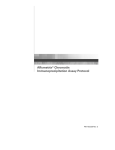
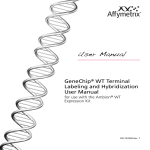

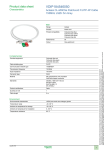
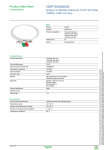
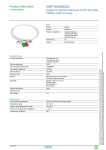
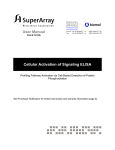

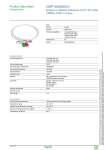
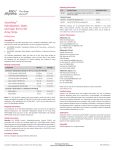
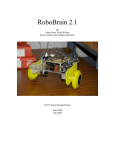
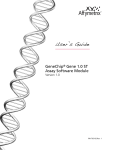
![or BTK [C481S] (cat. # CK-01-1002-384)](http://vs1.manualzilla.com/store/data/005787023_1-2d29b83e06663168d351d396f31f02d5-150x150.png)
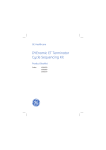
![or BTK [C481S] (cat. # CK-01](http://vs1.manualzilla.com/store/data/005981492_2-10b1708324ced5982eb1bb254f0262a2-150x150.png)

